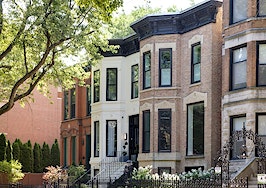The average American homebuyer is 45 years old, married or partnered, college-educated and likely to purchase a home located in the South, according to results on buyers from the 2021 Zillow Consumer Housing Trends Report (CHTR) released Wednesday.
Between March and August 2021, Zillow Group Population Science ran a nationally representative survey of more than 2,000 buyers. For this study, buyers were considered household decision makers who are 18 years or older and moved to a new primary residence that they bought within the last year. Survey respondents were not notified that Zillow Group was conducting the survey, to decrease response bias.
Age, race, geography
The largest proportion of U.S. homebuyers are between the ages of 30 and 39, at 26 percent of all buyers. After that, 23 percent of buyers are between 40 to 49 years old and 23 percent are aged 60 years or older. In general, U.S. buyers tend to be younger than homeowners who haven’t moved within the last year and older than the general renter population.
White or caucasian individuals make up the vast majority of buyers at 73 percent. The overall share of the U.S. population that is white is 63 percent. Meanwhile, 12 percent of U.S. adults are non-Hispanic Black or African American but only 7 percent of buyers are Black.

Credit: Zillow
Most homebuyers live in the South at 40 percent of all buyers, followed by 23 percent each in the West and Midwest, reflecting the regions with higher available inventory. Just 15 percent of buyers live in the Northeast.
Zillow’s report noted that the number of LGBTQ+ homebuyers has steadily grown since Zillow started collecting the data in 2019 when 7 percent of buyers identified as LGBTQ+. In 2020, 9 percent of buyers identified as such, and as of 2021, 12 percent of buyers identify as LGBTQ+.
Income, education, marital status
In terms of income, buyers tend to make more than the overall U.S. population. The national median household income in 2019 was $65,700, but according to Zillow’s survey, the annual median household income for buyers is about $86,000.
Buyers in 2021 are also more educated than the total population of American household decision makers — 45 percent of buyers have a four-year college degree or higher, compared to 34 percent of all U.S. household decision makers.
Since homebuying often correlates with other life events, like marriage or creating a family, it’s not surprising that 57 percent of homebuyers are married or partnered, while just 20 percent have never married.
In 2021, 40 percent of homebuyers had children under the age of 18 living with them, and 4 percent had parents or in-laws living with them. Over half have at least one dog and 39 percent have at least one cat.
Most buyers said they bought their home in the suburbs, at 44 percent of buyers. After that, 38 percent bought in an urban area, and 19 percent bought in a rural area.
Type of home
Three-bedroom single-family detached homes tended to be the norm for homebuyers in 2021. The median buyer purchased a three-bed, three-bath single-family detached home that was between 1,000 and 1,999 square feet. However, given low inventory and competition in the market this year, buyers who purchased townhomes and condos increased substantially from previous years — 11 percent of buyers purchased a townhome compared to 8 percent in 2020, and 10 percent purchased a condo compared to 6 percent in 2020.
First-time buyers
The number of first-time buyers in the market has been declining steadily for the past few years, but in 2021, competition and low inventory really hampered first-timers. Just 37 percent of buyers were first-time homebuyers this year, in contrast to 43 percent in 2020.

Credit: Zillow
Impacts of market competition and low inventory
The heat of the market in 2021 was also reflected in the increasing number of offers buyers typically had to make before buying a home. Only 36 percent of buyers made one offer during the homebuying process, compared to 48 percent in 2020, 49 percent in 2019 and 52 percent in 2018. Meanwhile, nearly 60 percent of buyers had to make two or more offers, up from 42 percent in 2020.
Going over budget has also become more likely for buyers in recent years, with 28 percent of buyers reporting going over their initial budget in 2021, compared to 23 percent that went above budget in 2018. Buyers with a mortgage were also more likely to go above budget, at 33 percent of buyers, compared with the 19 percent of cash buyers who went above budget.
In another reflection of this year’s challenging market, mortgage buyers were also more likely to have at least one mortgage denial before getting approved for a mortgage. Thirty-four percent of buyers faced at least one mortgage denial in 2021, up from 22 percent in 2020.

Credit: Zillow
Of those who have been denied a mortgage at least once, younger, non-white, first-time and LGBTQ+ individuals were more likely to fall into this category. Since older individuals have more time to build credit, pay off loans, and bolster their savings, it stands to reason that younger buyers might have more challenges with these factors and are at greater risk of mortgage denial as a result.
Racial disparities
Buyers of color, however, face often face additional challenges that tend to impact mortgage qualification — they’re typically less likely to benefit from intergenerational wealth, typically have lower household wealth, and are still negatively impacted by discriminatory segregation-era policies like redlining. In 2021, 54 percent of Black buyers and 56 percent of Latinx buyers reported at least one mortgage denial.

Credit: Zillow
Migration
Amid frequent headlines of America’s “great reshuffling” during the pandemic, most buyers actually stayed within the same metro area in 2021, although many changed neighborhoods or cities. Nearly 40 percent of buyers stayed in the same city, but moved neighborhoods, and 19 percent stayed in the same metro area, but moved to a new city within that metro. Fifteen percent of buyers moved to a different state, up from 14 percent in 2020 and 11 percent in 2019.
Home and neighborhood characteristics
The top five considerations when buying a new home have largely remained the same of the past few years, which includes how the home fits into their budget, whether it has air conditioning, number of bedrooms, storage space and number of bathrooms. However, storage space saw a slightly higher bump in importance in 2021 than previous years, being important to 75 percent of buyers this year, compared to just 68 percent in 2020.
The shift in working from home has made a significant impact on many American homeowners’ lives, but interestingly, does not appear to have made much of an impact on what neighborhood characteristics buyers value most.

Credit: Zillow
Over the past few years, the only desired neighborhood characteristic that changed substantially was “sense of community,” which increased in its importance for 47 percent of buyers in 2018 to 54 percent in 2021.
Impacts of technology
As digital offerings continue to become more robust in the real estate industry, consumer demand for things like digital floor plans and 3D or virtual tours has remained strong. Over 80 percent of buyers reported that they would be more likely to view a home if the listing included a floor plan that they liked, and 56 percent of buyers said they wasted time in their home search viewing a property in-person that they would have skipped, had they understood the floor plan in advance.
Meanwhile, 68 percent of buyers agreed that 3D tours helped them understand a space better than static listing photos, and 61 percent said they wished more listings had 3D tours. Those tours have also gradually given buyers more confidence over the years in making offers sight-unseen — 34 percent of buyers reported they were very confident in making an offer on a home they viewed as a 3D tour of but had not seen in-person, up from 32 percent in 2020.
Home tours
The pandemic does not seem to have dissuaded buyers much from visiting homes in-person or going to open houses. In fact, the typical buyer in 2020 and 2021 went on one additional private home tour than the typical buyer in 2018 and 2019 — three private home tours versus two.

Credit: Zillow
Meanwhile, 56 percent of buyers attended between one and four open houses in 2021, up from 44 percent in 2018.













